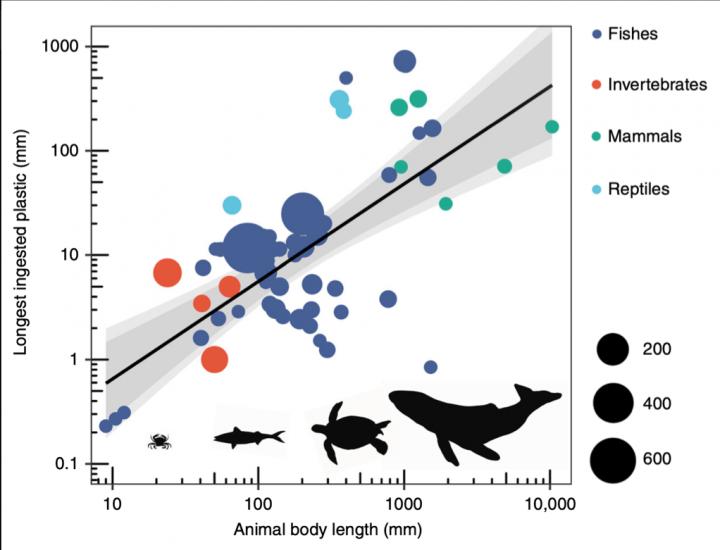The researchers, from the University’s Water Research Institute, looked at the gut contents of more than 2,000 animals to create a simple equation to predict the size of a plastic item an animal can eat, based on the length of its body.
In the study, published today in Nature Communications, they report that the length of an animal can be used to estimate the biggest piece of plastic it can eat – and this was about 5% (a twentieth) of the size of the animal.
The researchers say that as the plastic pollution problem escalates, it is vital to be able to quickly assess the risk of plastics to different species around the world.
This work could also help scientists measure the risk of plastic pollution to ecosystems and food supplies – and ultimately the risk to human health.
By trawling through published data, the team found plastics ingested by marine and freshwater mammals, reptiles, fishes and invertebrates, from 9mm-long fish larvae to a 10m-long humpback whale.
During their research they found some shocking examples of the extent of plastic pollution, including hosepipes and flower pots in a sperm whale, plastic banana bags inside green turtles and a shotgun cartridge in a True’s beaked whale.
Co-lead author of the study Dr Ifan Jâms said: “We still know very little about the way most animals feed in the wild, so it’s difficult to figure out how much plastic they could be eating.
“This information gives us a way to start measuring the extent of the plastic pollution problem.
“We hope this study lays a foundation for including the ‘ingestibility’ of plastics into global risk assessments.
“We also hope this work will encourage more sophisticated assessments of the amount of plastic that may be moving into global ecosystems and food supplies.”
Project leader Professor Isabelle Durance said: “All of us will have seen distressing, often heart-breaking, images of animals affected by plastic, but a great many more interactions between animals and plastic are never witnessed. This study gives us a new way of visualising those many, many unseen events.
“While we understand increasingly where concentrations of plastic in the world’s aquatic ecosystems are greatest, it’s only through work like this that we can know which animals are likely to be in danger from ingesting it.
“Through this work, we can also begin to understand how much plastic is entering global food webs or human foods, for example, because we know the general sizes of plastic likely to be taken in by zooplankton or fishes.
“We recognise that our research is part of wider efforts and there is still more work to do to quantify the risks from smaller plastic fragments or to understand the damage caused by plastic ingestion, but we hope this work helps the world to address its growing plastic problem.”
The researchers said further work was needed to look at how and where terrestrial animals eat plastic to predict wider risks.
###
Original post https://alertarticles.info


